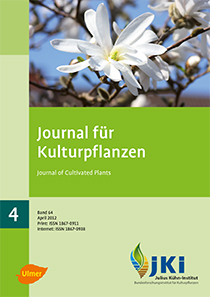Weed composition and herbicide use strategies in sugar beet cultivation in Germany
DOI:
https://doi.org/10.5073/JfK.2012.04.02Keywords:
Herbicides, active ingredients, treatment index, difficult-to-control weeds, NEPTUN-survey, Sugar Beet Cultivation-survey, Integrated Pest Management, National Action PlanAbstract
Weed composition and herbicide use in sugar beet fields varied in the last decades. This study was conducted to determine and analyse changes in weed composition and herbicide use strategies on regional and national scale in Germany based on data of the Sugar Beet Cultivation-survey (1994–2010) and NEPTUN-survey – Sugar Beet (2005, 2007 and 2009). On national scale, the occurrence of the most important common weeds has partly tripled and difficult-to-control weeds partly doubled from 1996 to 2010. Most important common weeds were goosefoot (CHESS), knotweed (POLSS) and cleaver (GALAP) with a spread of at least 36% up to 79%. The most difficult-to-control weeds were knotweed (POLSS), annual mercury (MERAN) and fool‛s parsley (AETCY), which occurred on less than 26% of the acreage in 2010. Acreage of mulch tillage systems and post-emergence treatments increased, while treatment frequency was relatively constant at approximately 3.0–3.5. Number of herbicide products and active ingredients used per treatment were relatively constant at 2.5 and 4.0, respectively, but treatment index per treatment changed significantly between the years from 2.0 to 2.4. Exemplarily, fields of exemplary regions in the north, west and south were characterised by specific weed compositions, which were regulated by adopted herbicide use strategies. Strategies differed in treatment frequency, varying from 2.9 to 4.5, number of herbicide products per treatment, varying from 2.2 to 3.5, number of active ingredients per treatment, varying from 3.6 to 4.8 and treatment index, varying from 1.47 to 2.51 in 2009. For the first time, the analysis of weed composition was done in relation to herbicide use strategies by comparable data. Weed species-specific adoption of treatment patterns, herbicide use intensity and reduced application rates clarify the implementation of the Integrated Pest Management in sugar beet cultivation, which is part of the EU-Directive 2009/128/EG for a sustainable use of pesticides.
Published
Issue
Section
License
The content of the journal is licensed under the Creative Commons Attribution 4.0 License. Any user is free to share and adapt (remix, transform, build upon) the content as long as the original publication is attributed (authors, title, year, journal, issue, pages).
The copyright of the published work remains with the authors. The authors grant the Journal of Cultivated Plants, the Julius Kühn-Institut and the OpenAgrar repository the non-exclusive right to distribute and exploit the work.







